In this guide, we’ll discuss lead generation KPIs (Key Performance Indicators) and the essential metrics that can help you grow your agency. We’ll explore why tracking these metrics is important to your bottom line, how they help optimize campaigns, and then dive into 18 key lead generation KPIs that should be on your radar.
Ready to improve your local lead generation efforts with lead generation best practices and strategies? Of course you are. Let’s get started.
Here’s what’s inside:
- Website and traffic metrics to lead quality and cost and revenue metrics.
- Benchmarks and industry standards.
- Setting realistic targets based on your lead generation business model.
- Tools and techniques for measuring lead generation KPIs effectively.
- Tips for optimizing lead generation metrics, including identifying areas for improvement, SEO lead generation, A/B testing campaigns, and refining targeting and messaging strategies.
Sell smarter and scale faster with AI-powered CRM
Why Tracking Lead Generation Metrics is Important
A better question would be, when wouldn’t it be important?
Tracking lead generation metrics is the number one best way to understand the effectiveness of your marketing campaigns. You see, metrics provide valuable info about campaign performance, allowing digital agencies like yours to gauge the success of their strategies and identify areas that might need improving.
By analyzing metrics such as conversion rates, website traffic, and lead quality, digital marketing agencies can (and will) make smarter, data-driven decisions faster than you, capturing leads that could have been yours. This is why optimizing your lead generation efforts with KPIs is so important to stay on top.
How Lead Generation KPIs Help Optimize Campaigns and Drive Revenue
Now that we have gotten the “why” out of the way, let’s get into the “how.”
Lead generation KPIs play a vital role in optimizing your campaigns and driving revenue growth. They help digital marketing agencies identify both strengths and weaknesses in their marketing efforts by highlighting areas of success and areas needing improvement.
By focusing on improving KPIs such as conversion rates, cost per lead, and customer lifetime value, your agency can directly impact its bottom line and increase revenue.
The correlation between improved KPIs and increased revenue highlights the importance of tracking and optimizing these metrics in your lead generation strategies.
18 Key Lead Generation KPIs to Track
Here’s a summary of each of the lead generation KPIs you should be keeping track of:
Website and Traffic Metrics
1. Bounce Rate
Bounce rate indicates the percentage of visitors who leave your site after viewing only one page.
A high bounce rate may suggest that visitors are not finding what they need, so optimizing your website content and user experience is important here.
Analyze bounce rate by segmenting your lead generation data based on different pages or traffic sources to identify problematic areas and make necessary improvements.
2. Website Traffic
Tracking overall website traffic provides insights into the effectiveness of your marketing efforts and the popularity of your content. But this can only take you so far.
Try segmenting your traffic data by source, location, device, and other demographics to gain an even deeper understanding of your audience’s behavior and preferences. From there, use this data to tailor your lead generation content marketing strategies to meet the needs of your target audience better.
Pro Tip: Build fast, secure, and beautiful WordPress websites for your client’s businesses with a suite of developer tools that do the heavy lifting for you—all with Website Pro.
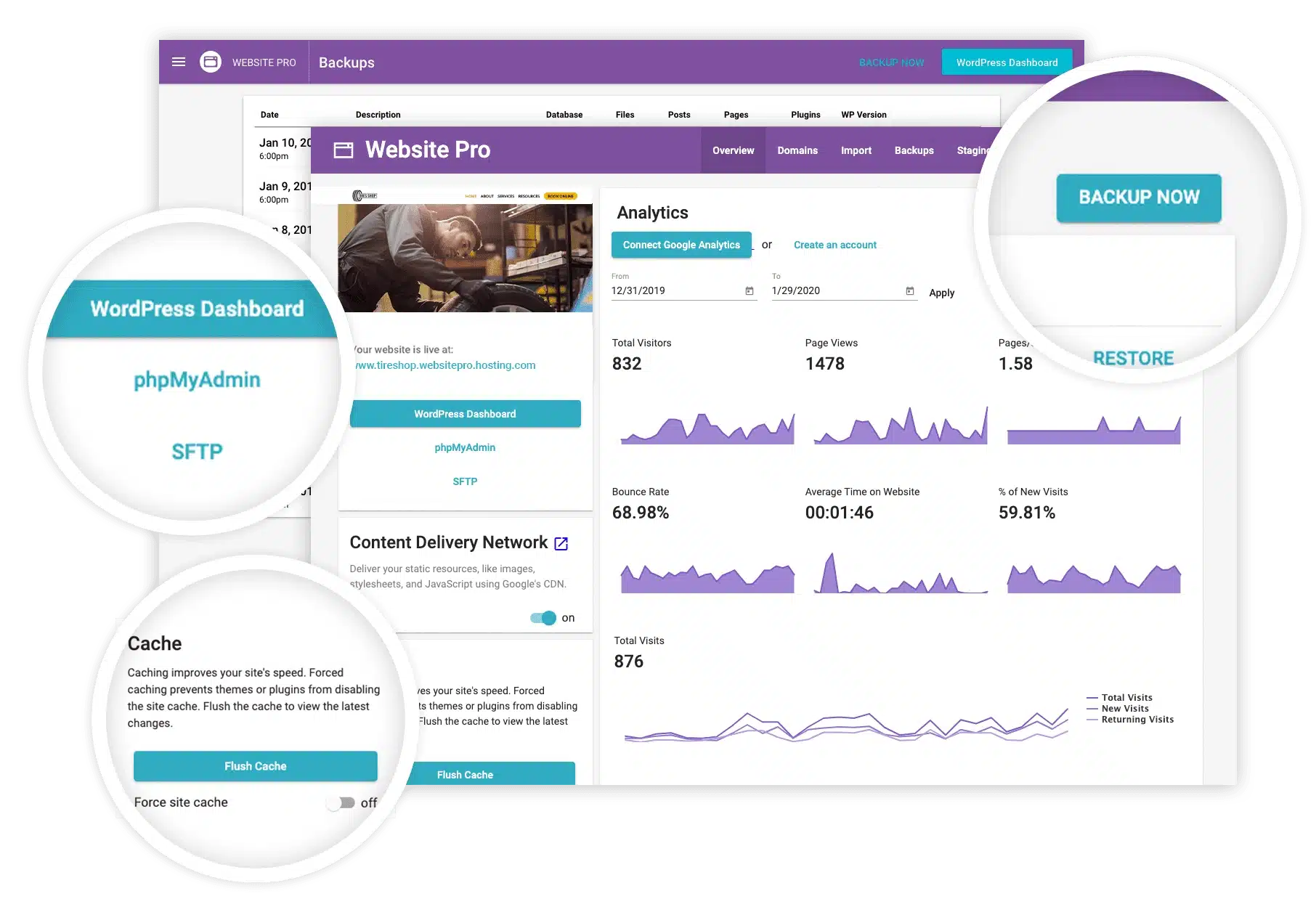
3. Traffic Sources
Different traffic sources, such as organic lead generation search, paid advertising, and referral traffic, have varying levels of relevance and effectiveness for your digital marketing agency.
You see, by understanding the performance of each traffic source, you can allocate resources more effectively and optimize your marketing strategies to focus on channels that drive the most valuable traffic to your website.
4. Page Engagement Metrics
Key page engagement metrics like time on page and pages per session tell you how visitors interact with your website content.
A higher time on page and pages per session generally indicates that visitors find your content valuable and engaging.
Analyze these metrics to identify the most popular content and where things are falling flat. From there, you can optimize page load times and enhance your content’s relevance.
Lead Quality Metrics
5. Lead Value/Quality Score
Lead value or quality score helps prioritize leads based on their likelihood to convert into customers.
You can develop a lead scoring system by assigning values to different lead attributes, such as demographics, behaviors, and engagement levels. This is useful because this lead generation system allows you to focus your efforts on leads with the highest potential for conversion, and not have to bother with the rest.
6. Marketing Qualified Leads (MQLs)
The next lead generation KPI is MQLs, which are leads that have been identified as having a higher likelihood of becoming customers based on their engagement with marketing efforts.
You can establish criteria for qualifying leads as MQLs, such as specific behaviors or demographics. By nurturing MQLs through targeted marketing campaigns, you can move them further down the lead generation funnel.
7. Sales Qualified Opportunities (SQOs)
SQOs are leads that have been further qualified by your sales team and are ready to engage in sales conversations.
Your team can identify SQOs based on BANT criteria: budget, authority, need, and timeline.
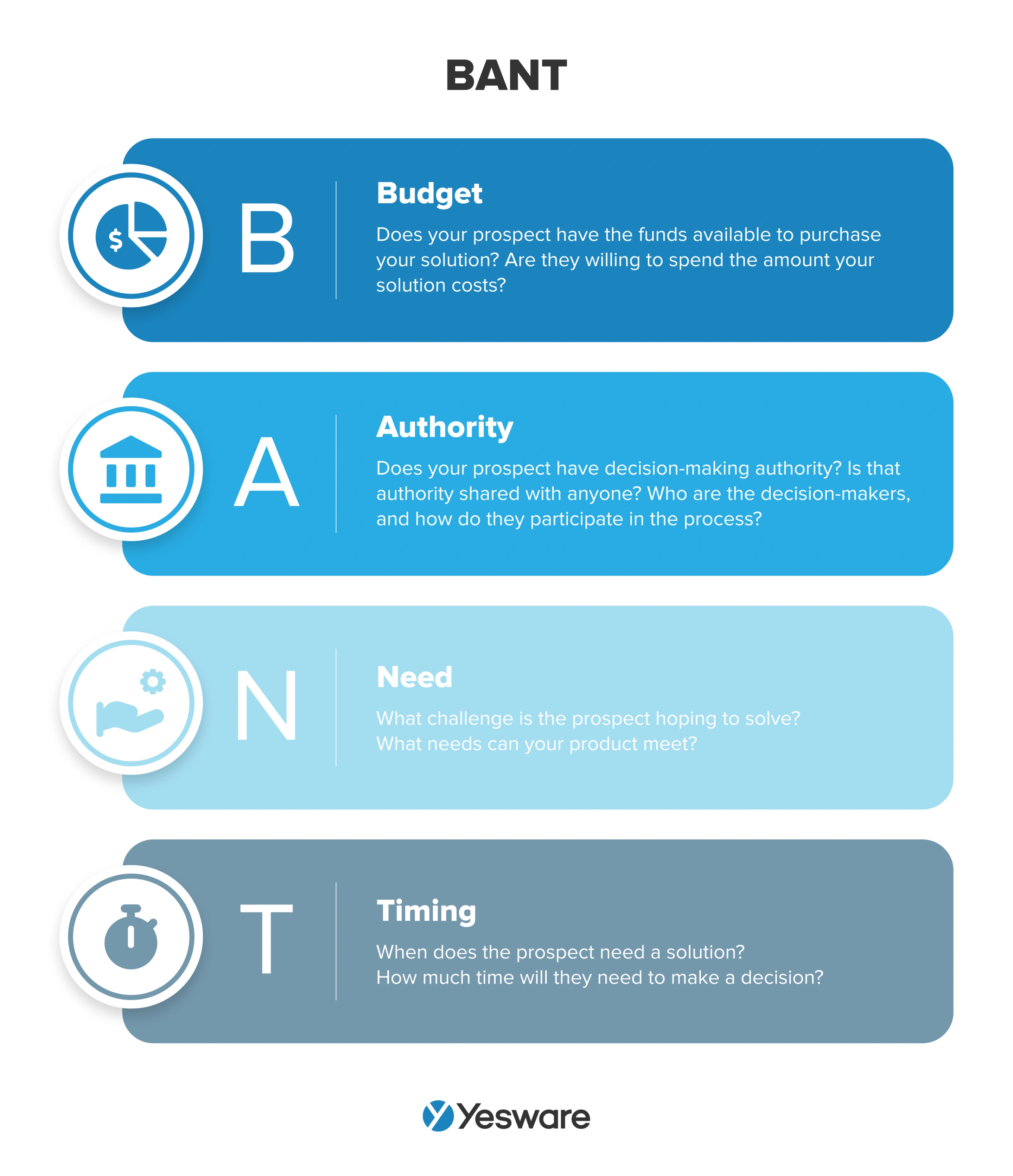
So, how do you best engage with this type of lead? For SQO leads, you can nurture them with personalized sales efforts to increase the likelihood of conversion.
8. Conversion Rates:
Conversion rates measure the percentage of visitors who take a desired action, such as filling out a form or making a purchase on your lead generation website.
You’ll need to analyze various conversion rates, such as landing page to lead conversion rate and lead to customer conversion rate, to identify areas for improvement in your conversion funnel.
To optimize conversion rates, focus on improving your website’s design and functionality (this is a BIG one, you can thank us later), making the conversion process extremely simple, and targeting high-intent keywords in your marketing campaigns.
Cost and Revenue Metrics
9. Cost per Lead (CPL)
CPL calculates the average cost incurred to acquire a single lead.
You’ll need to monitor CPL closely to ensure that your lead generation efforts are cost-effective, otherwise, you’ll start bleeding money—and fast.
Strategies for reducing CPL include optimizing ad targeting, improving landing page conversion rates, and running lead nurturing campaigns to increase lead quality.
10. Cost per Acquisition (CAC)
CAC determines the average cost of acquiring a new customer or client.
Lowering CAC is an important task for improving the profitability of your lead generation efforts.
To manage and lower CAC, focus on improving lead quality, increasing customer retention rates, and optimizing marketing channels with the highest return on investment.
11. Customer Lifetime Value (CLV)
Wouldn’t it be great to predict the future? This is very much possible with the lead generation KPI CLV.
CLV predicts the total revenue a customer is expected to generate over the lifetime of the relationship. In fact, with customer relationship management (CRM) and billing software like ours, this forecasted revenue calculation happens automatically.
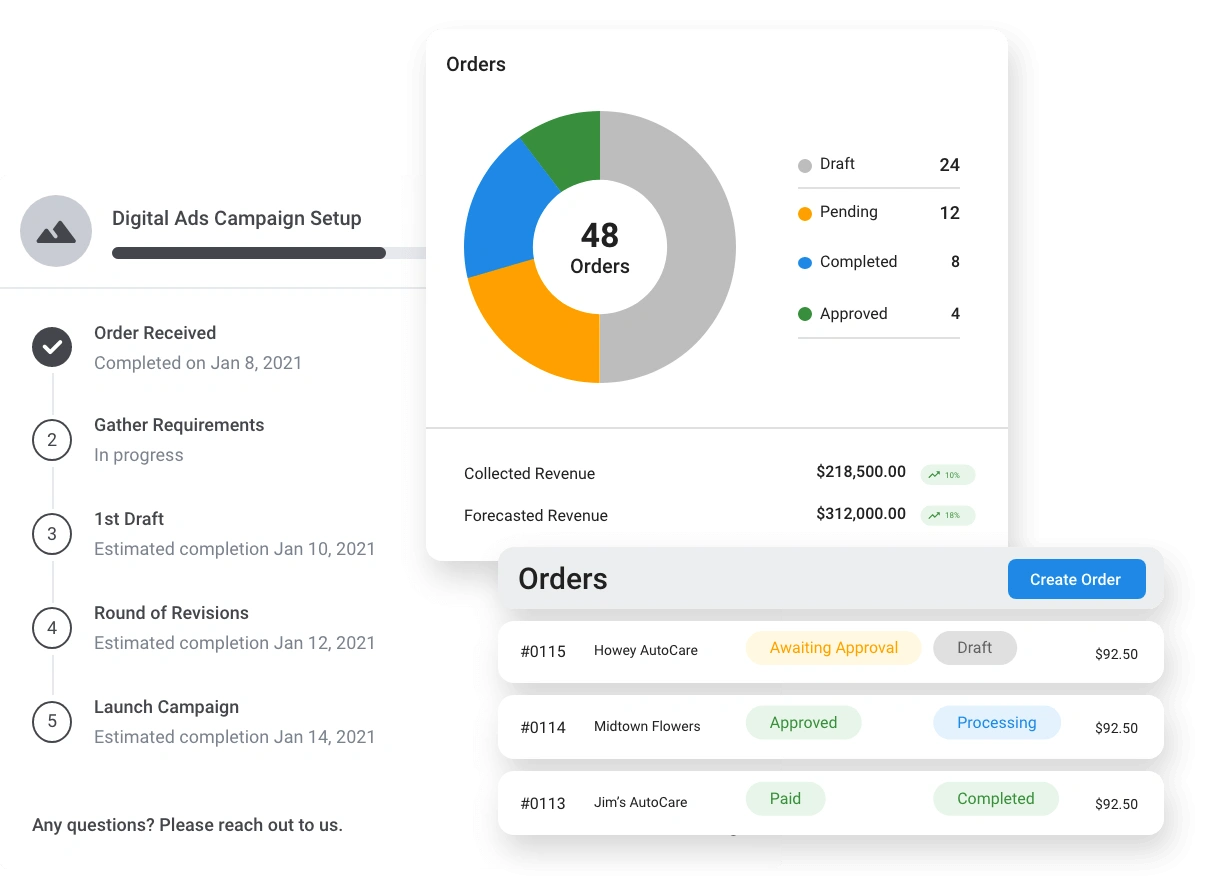
Increasing CLV should really be on your radar because it is essential for maximizing long-term profitability, customer loyalty, and investor retention.
You can maximize CLV by improving customer satisfaction, increasing average order value, and implementing customer retention strategies.
12: Average Deal Size
Average deal size measures the average value of a sale or transaction. Increasing average deal size can greatly impact revenue growth quickly.
To increase average deal size, upsell or cross-sell complementary products or services, offer bundled packages, and provide tiered pricing options to encourage customers to upgrade.
Pro Tip: Need help finding what to upsell? Our Snapshot Report’s AI integration automatically analyses your prospects’ online presence to recommend the right products for their needs.
Like this:
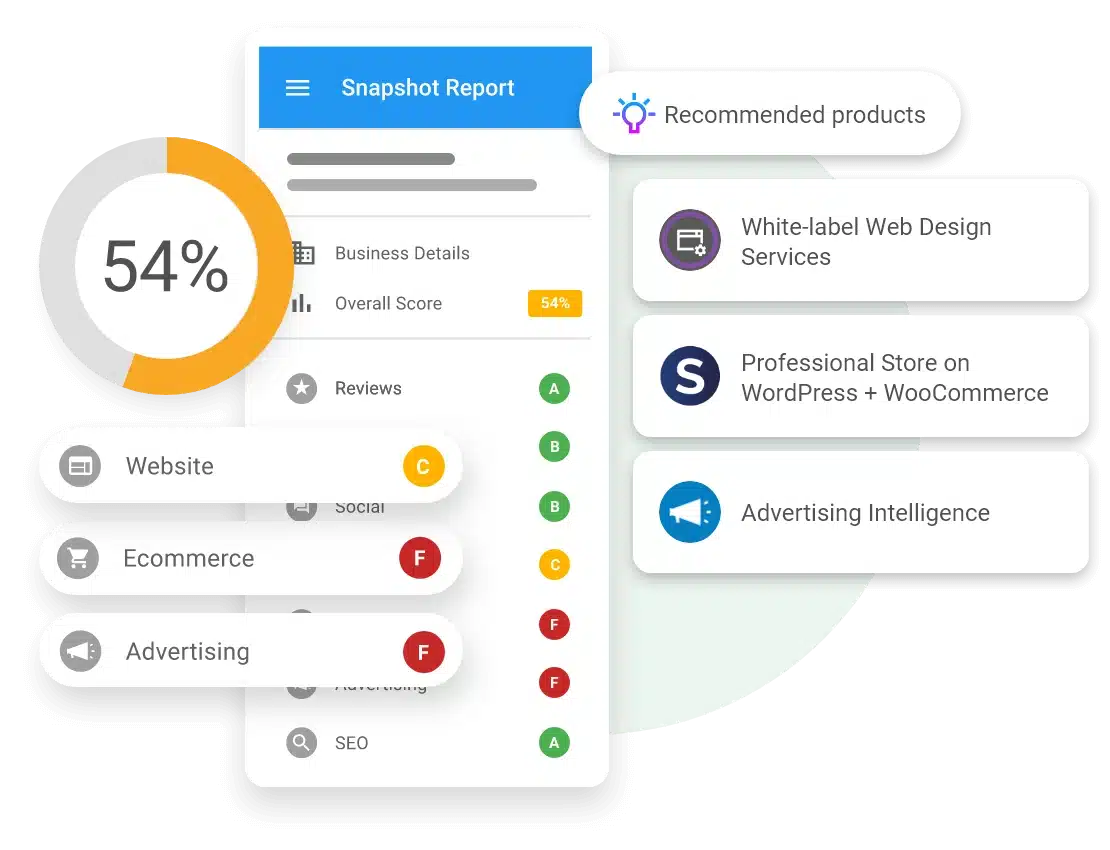
Coupled with our easy-to-use invoicing solution, you’re well on your way to increasing your average deal size in no time.
13. Monthly Recurring Revenue (MRR)
MRR tracks the predictable monthly revenue generated from subscription-based services.
Growing MRR is especially important for subscription-based businesses to achieve sustainable revenue growth.
Strategies to grow MRR include:
- Acquiring new subscribers.
- Retaining existing subscribers.
- Upselling premium subscription tiers.
14. Return on Investment (ROI)
ROI measures the profitability of your lead generation efforts by comparing the revenue generated to the costs incurred.
Improving ROI requires optimizing marketing campaigns to increase conversion rates and reduce acquisition costs.
Try to focus on targeting high-value leads, optimizing ad spend, and tracking the performance of individual marketing channels to maximize your ROI.
Other Important Metrics
15. Email Marketing Performance
Key email lead generation metrics like open rates and click-through rates give you a clearer picture of if people are interested in your content, or if it is going straight to the bin.
To improve your email marketing performance, segment your email list based on subscriber behavior and preferences, personalize email content, and do things like test:
- Different subject lines.
- Call-to-actions (CTAs).
- Send times.
Pro Tip: If your email writing skills are not where you want them to be, Vendasta’s AI Tools help you build convincing campaigns in minutes. Check it out:
16. Inbound Lead Response Time
Quick response times for inbound leads are important for improving your conversion opportunities and client satisfaction.
To implement strategies that reduce response time, try tactics such as using automation tools for lead routing and follow-up, setting up instant lead notifications, and establishing clear communication processes between your marketing and sales teams.
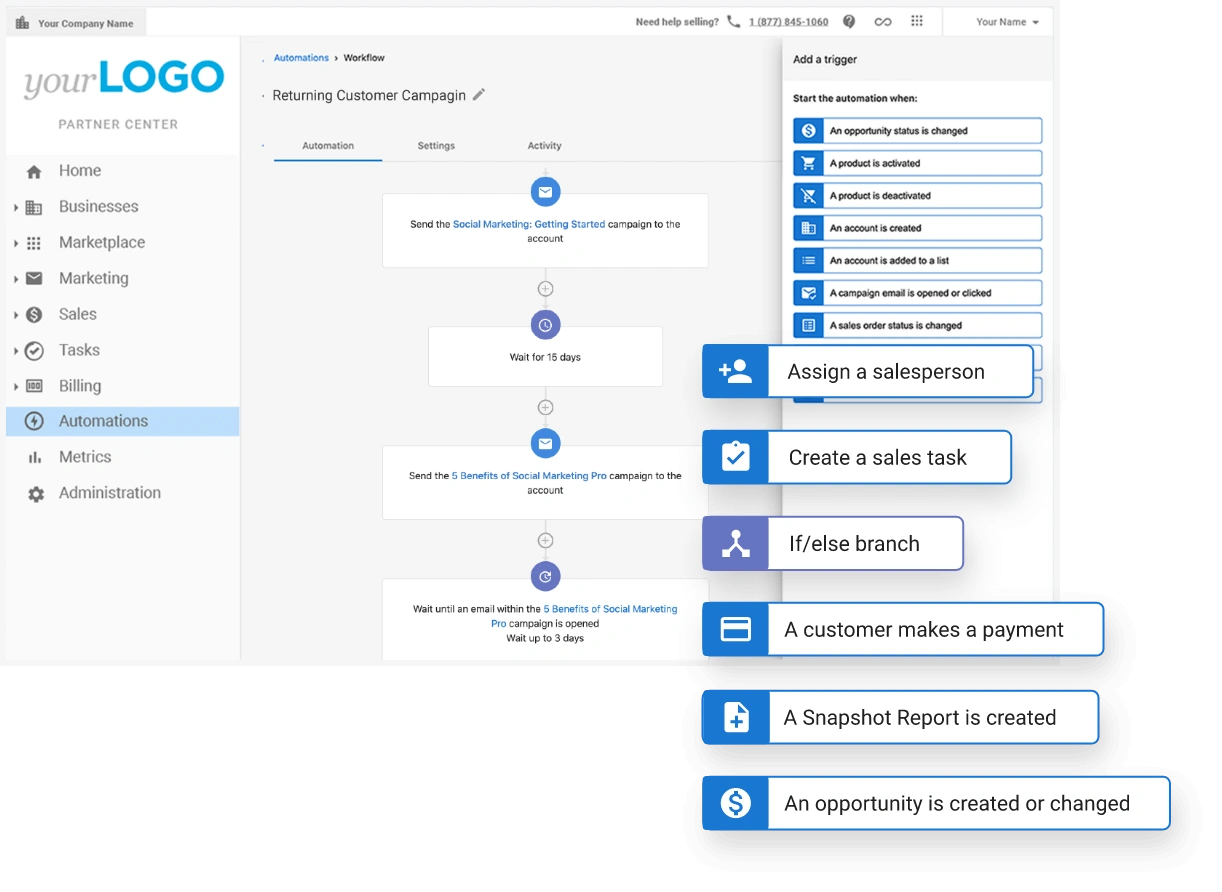
17. Sales Cycle Length
Sales cycle length refers to the average time it takes for a lead to move through the sales process from initial contact to conversion.
Shortening the sales cycle means more money faster.
To shorten the sales cycle, identify and address common bottlenecks in the sales process, and identify where prospects are falling off. You can also try streamlining communication between sales and marketing teams, and provide targeted content and resources to facilitate decision-making.
Pro Tip: Looking for sales collateral? In the Vendasta Marketplace, you can access FAQs, white-label resources and brochures perfectly designed to help your prospects get over the finish line. 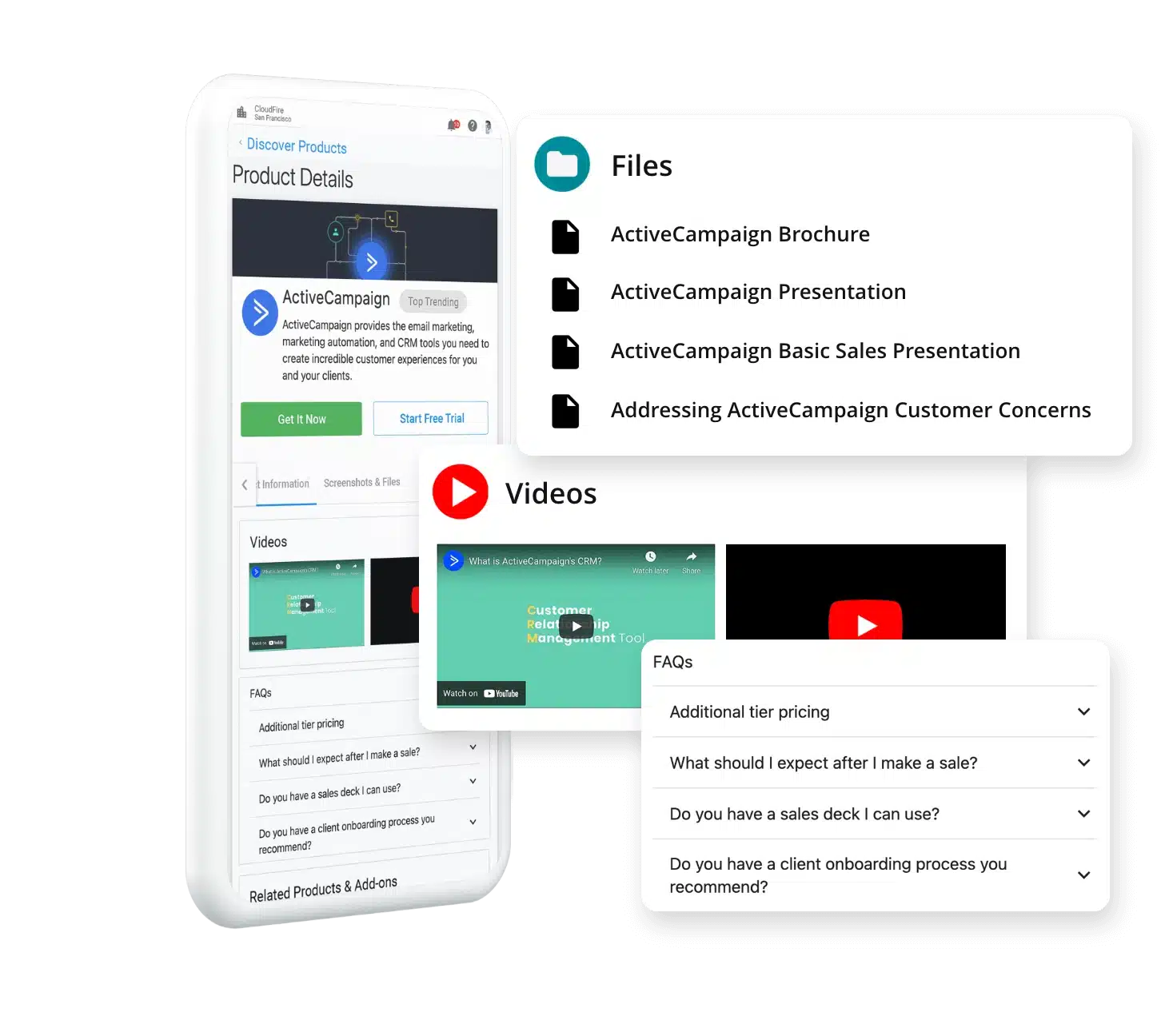
18. Average Time to Revenue
The last lead generation KPI we’ll look at is average time to revenue.
Average time to revenue measures the average time it takes from lead generation to revenue realization.
Reducing the time to revenue is the key to maintaining cash flow and accelerating your agency’s growth.
To reduce the time to revenue, a great bet is to streamline lead qualification and sales processes, prioritize high-intent leads, and invest in a quality CRM lead generation platform.
Benchmarks and Industry Standards
Average Figures for Key Metrics
Understanding industry benchmarks helps put things into perspective when assessing the performance of your lead generation efforts. Here are some average benchmark figures for key lead generation KPIs across various industries:
B2B Software/Technology
- CPL: $164 – $310 (Statista)
- MQL to SQL Conversion Rate: 13% – 26% (Mosiac)
- Sales Cycle Length: 2.5 months (DataBox)
E-commerce/Retail
- Conversion Rate: 2.5% – 3% (Shopify)
- Average Order Value: $110 (BigCommerce)
- Return on Ad Spend (ROAS): 287% (BeProfit)
Financial Services
- Cost per Acquisition (CAC): $$784 (First Page Sage)
- Customer Lifetime Value (CLV): $$45,976 (First Page Sage)
Healthcare/Wellness
- Email Open Rate: 41.23% (Paubox)
- Average Cost Per Lead (CPL): $47.69 (Wordstream)
- Click-through Rate (CTR): 5.66% (Wordstream)
How to Use Benchmarks to Evaluate Performance
Once you have benchmark data for your industry, compare your own KPIs against these averages to assess your performance. If your metrics fall below industry standards, it may indicate spots to work on in your lead generation plan.
Conversely, if your metrics exceed industry averages, you may be outperforming competitors and can use this advantage to further optimize your efforts.
How to Set Realistic Targets Based on Your Business
Here are some tried and true methods for setting achievable KPI targets:
Historical Data Analysis
Review past performance data to identify trends and set realistic improvement targets based on achievable growth rates.
SMART Goals
This concept is short for goals that are:
- Specific
- Measurable
- Achievable
- Relevant
- Time-bound
For example, you could try to increase your MQL to SQL conversion rate by 10% within the next quarter.
Competitor Analysis
How are you doing against your competitors? This information is not always easy to come by, but you can still benchmark your performance against similar businesses and industry leaders who release this data publicly to establish realistic targets that align with market standards.
Consultation with Stakeholders
When setting goals, you can never have too many cooks in the kitchen. Involve key stakeholders, such as investors, and sales and marketing teams in the goal-setting process to ensure alignment with overall business objectives and resources.
The Importance of Aligning Targets With Business Goals
Setting lead generation KPI targets that align with your digital agency’s goals ensures that your lead generation efforts contribute directly to the success of your organization.
Whether your primary objectives are to increase revenue, improve customer acquisition, or improve brand awareness, aligning KPI targets with these goals provides clarity and direction for your marketing strategy.
When steering a ship, your whole crew must be paddling in the same direction. Aligning targets with your goals enables accountability and allows for more effective resource allocation and prioritization of initiatives that drive better, more tangible outcomes.
Lead Generation KPI Measurement Tools and Techniques
Analytics Platforms
Analytics platforms are the perfect way to track and analyze key metrics related to your lead generation efforts. Here are some great analytics tools and their features:
Google Analytics:
- Tracks website traffic, user behavior, and conversion metrics.
- Provides insights into audience demographics, acquisition channels, and content performance.
- Offers customizable reporting and goal-tracking features.
Adobe Analytics:
- Offers advanced analytics capabilities for tracking and analyzing website and app data.
- Provides real-time reporting, segmentation, and predictive analytics features.
- Integrates with other Adobe Marketing Cloud solutions for comprehensive marketing insights.
How to Integrate These Tools for Comprehensive Tracking
To maximize the effectiveness of analytics platforms, integrate them with other lead generation tools and systems such as your CRM software, email marketing platform, and advertising platforms.
This integration allows for pain-free data sharing and provides a holistic view of your lead generation efforts across various channels.
You can also utilize tracking codes, UTM parameters, and API integrations to ensure data consistency and accuracy across all platforms.
CRM Integration
CRM systems play a vital role in lead management and tracking KPIs throughout the customer journey.
Here’s why CRM integration is important:
- CRM systems centralize customer data and interactions, providing valuable insights into lead quality, sales pipeline, and customer behavior.
- Integration with CRM allows marketers to track lead generation KPIs, such as MQLs, SQLs, conversion rates, and revenue attribution, directly within the CRM platform.
- CRM integration facilitates lead nurturing, sales alignment, and personalized marketing campaigns based on CRM data.
CRM Integration Tips
Here are tips for integrating CRM with other marketing tools:
- Choose CRM and marketing automation platforms that offer native integrations or strong API capabilities for seamless data syncing.
- Ensure data mapping and field mapping between CRM and marketing tools to maintain data integrity and consistency.
- Leverage automated workflows to trigger actions based on CRM data, such as lead scoring, email nurturing, and sales alerts.
- Train sales and marketing teams on CRM usage and data management best practices to ensure alignment and collaboration.
Pro Tip:
Struggling to keep up with a million subscriptions just to use your CRM tools? One broken integration can lead to a world of headache. Our comprehensive all-in-one platform combines sales, marketing, workflow automations, billing, reporting, and payments all under one login so you can keep selling, and stop stressing.
Call Tracking
The role of call tracking in lead generation includes:
- Allowing businesses to attribute phone calls to specific marketing campaigns or channels, providing insights into the effectiveness of offline lead generation efforts.
- Tracking inbound calls from various sources, such as website visits, online ads, and print media, to measure the ROI of marketing initiatives accurately.
- Enabling marketers to optimize ad spend, target high-converting channels, and improve the overall customer experience by analyzing call data and trends.
How to set up and utilize call tracking:
- Choose a call-tracking platform that offers features such as dynamic number insertion, call recording, and call analytics.
- Implement unique phone numbers for different marketing channels or campaigns to track inbound calls accurately.
- Integrate call tracking with your CRM system to attribute calls to specific leads or customers and track call outcomes.
- Analyze call data to identify trends, optimize marketing campaigns, and improve lead generation strategies, such as keyword targeting, ad messaging, and audience segmentation.
Lead Scoring Models
Let’s quickly define lead scoring models and their benefits:
- Lead scoring is a methodology used to rank and prioritize leads based on their perceived value or likelihood of converting into customers.
- Lead scoring models assign numerical values to lead attributes and behaviors to calculate an overall lead score and pinpoint the best leads to focus your time on.
Lead Scoring Steps
Here are some steps for developing and implementing an (actually good) lead scoring system:
- Define Lead Criteria:
- Identify key lead attributes and behaviors that indicate buying intent or fit with your ideal customer profile.
- Determine scoring criteria based on factors such as job title, company size, website interactions, email engagement, and lead source.
- Assign Weight to Criteria:
- Assign numerical weights or scores to each lead attribute or behavior based on its importance and predictive value.
- For example, a lead with a higher job title or frequent website visits may receive a higher score than a lead with a lower job title or minimal engagement.
- Calculate Lead Score:
- Use a scoring formula or algorithm to calculate the overall lead score based on the weighted criteria.
- Aggregate scores from different lead attributes to generate a total lead score for each prospect.
- Set Thresholds and Segments:
- Establish scoring thresholds to help you tell the difference between lead quality levels, such as hot, warm, and cold leads.
- Segment leads based on their scores to tailor marketing and sales efforts and prioritize follow-up actions.
- Monitor and Refine:
- Continuously monitor lead scoring performance and adjust scoring criteria or weights as needed based on feedback and results.
- Collaborate with your sales team to validate lead scores and refine the AI lead scoring model to improve accuracy and alignment with sales outcomes.
Tips for Optimizing Lead Generation KPI Metrics Based on Insights
Identifying Areas for Improvement
Here’s how to analyze lead generation KPI data to identify potential cracks:
- Conduct a thorough analysis of key lead generation KPIs to identify areas where performance is below expectations or industry benchmarks.
- Look for trends, patterns, and abnormalities in the data that may indicate underlying issues or opportunities for improvement.
- Utilize data visualization tools and techniques to make it easier to spot trends and anomalies in the data.
- Remember, your business is not operating in a vacuum. So, consider conducting a root cause analysis to uncover the underlying factors contributing to these performance weaknesses.
Examples
Examples of common areas for improvement:
- High Bounce Rate: Identify lead generation landing pages with high bounce rates and analyze factors such as page load time, content relevance, and user experience to improve overall engagement.
- Low Conversion Rates: Examine conversion funnels and identify friction points or barriers preventing your visitors from converting, such as complex forms or unclear CTAs.
- Ineffective Traffic Sources: Evaluate the performance of different traffic sources and reallocate resources to channels that drive higher-quality leads and conversions.
- Poor Lead Quality: Review lead quality metrics such as lead scoring and MQL conversion rates to identify leads that are unlikely to convert into customers and refine your targeting criteria.
A/B Testing Campaigns
Now, let’s talk about the importance of A/B testing in lead generation optimization:
- A/B testing, also known as split testing, allows marketers to compare two or more variations of a marketing asset or campaign to determine which performs better.
- A/B testing helps identify the most effective messaging, design elements, and CTAs to optimize lead generation efforts so you can improve your conversion rates.
- By testing these different variables, marketers can make more suitable, data-driven decisions to improve campaign performance and achieve better results over time.
A/B Testing Tips
Tips for conducting effective A/B tests:
- Set Clear Objectives: Define specific goals and metrics to measure the success of the A/B test, such as click-through rates, conversion rates, or lead quality.
- Test One Variable at a Time: Focus on testing one element at a time, such as headline copy, button color, or email subject line, to isolate the impact of each variable.
- Segment Your Audience: Divide your audience into distinct segments based on relevant criteria.
- Run Tests Simultaneously: Conduct A/B tests concurrently to minimize external factors and ensure an accurate comparison between test variations.
- Monitor Results Closely: Don’t let things sit for a while. Track key metrics and monitor test results in real time to identify statistically significant differences between test variations.
- Iterate and Optimize: Use insights from A/B tests to iterate and refine marketing strategies continuously, incorporating winning variations into future campaigns for ongoing improvement.
Refining Targeting and Messaging
Practice makes perfect.
Here’s how to use lead generation KPI data to refine audience targeting:
- Analyze demographic, behavioral, and psychographic data to identify high-value audience segments that are most likely to convert.
- Use lead scoring and segmentation techniques to categorize leads based on their likelihood to convert and tailor your targeting strategies to achieve that.
- Leverage data-driven insights to personalize messaging and offers for different audience segments, addressing their unique needs, pain points, and motivations.
Strategies to Improve Messaging
Lastly, here are some strategies for improving messaging based on insights:
- Understand Audience Pain Points: Conduct market research and send out customer surveys to gain insight into audience pain points, challenges, and aspirations.
- Craft Compelling Value Propositions: Develop clear and compelling value props that connect meaningfully with your target audience and address their specific needs.
- Test Different Messaging Approaches: Too passive? Too salesy? Experiment with different messaging angles, tone of voice, and communication styles to determine which resonates most effectively with your audience.
- Use Social Proof and Testimonials: Your best asset is your happy customers. Incorporate social proof elements such as customer testimonials, case studies, and reviews to build trust and credibility with your audience.
- Optimize Call-to-Action (CTA): Test different CTA button designs, copy, and placement to encourage desired actions and improve conversion rates.
- Track and Iterate: Continuously monitor the performance of messaging variations and iterate based on feedback and insights to optimize results over time.
FAQs
1. What are lead generation KPIs?
Lead generation KPIs (Key Performance Indicators) are measurable metrics that help agencies track and evaluate the effectiveness of their marketing campaigns. They reveal how well strategies attract, convert, and retain leads—ultimately determining the success and ROI of lead generation efforts.
2. Why are lead generation KPIs important for digital agencies?
Tracking lead generation KPIs helps agencies identify which marketing channels perform best, optimize campaign budgets, and improve conversion rates. By focusing on data-driven insights, agencies can make smarter decisions that directly boost client revenue and long-term growth.
3. What are the most important lead generation KPIs to track?
Key lead generation KPIs include conversion rate, cost per lead (CPL), customer acquisition cost (CAC), lead quality score, and customer lifetime value (CLV). Together, these metrics show how efficiently campaigns turn leads into paying customers.
4. How can I measure lead generation KPIs effectively?
Use analytics and CRM tools to track website traffic, conversions, and lead data across all campaigns. Vendasta’s all-in-one platform integrates lead tracking, reporting, and automation, allowing agencies to measure performance and generate client-ready reports in one dashboard.
5. What is a good conversion rate for lead generation?
A healthy conversion rate varies by industry, but most businesses aim for 2–5% on landing pages. Higher-performing campaigns may exceed 10% with optimized offers, clear calls to action, and consistent A/B testing to improve audience engagement.
6. How does Vendasta help agencies improve lead generation KPIs?
Vendasta provides AI-powered tools like the Snapshot Report, CRM, and marketing automation software that help agencies capture, nurture, and convert leads. With real-time analytics, agencies can easily identify performance gaps and boost key metrics like CPL and ROI.
7. How do lead quality and lead quantity differ as KPIs?
Lead quantity measures how many leads are generated, while lead quality evaluates how likely they are to convert. A high number of unqualified leads isn’t valuable—focusing on quality leads produces better ROI and stronger long-term client relationships.
8. What tools can agencies use to track lead generation KPIs?
Popular options include Google Analytics, HubSpot, Salesforce, and Vendasta’s CRM. Vendasta stands out for agencies because it combines lead tracking, scoring, marketing automation, and reporting in one white-label platform designed for scalability.
9. How can I improve poor lead generation KPI performance?
Start by reviewing key metrics like bounce rate, CPL, and conversion rate. Optimize landing pages, refine targeting, and use lead nurturing campaigns. Data insights from tools like Vendasta’s Snapshot Report can guide high-impact improvements.
10. How often should agencies review lead generation KPIs?
Agencies should monitor lead generation KPIs weekly and conduct deeper performance reviews monthly or quarterly. Regular tracking helps spot early trends, identify declining metrics, and make timely adjustments that maintain steady growth and ROI.


